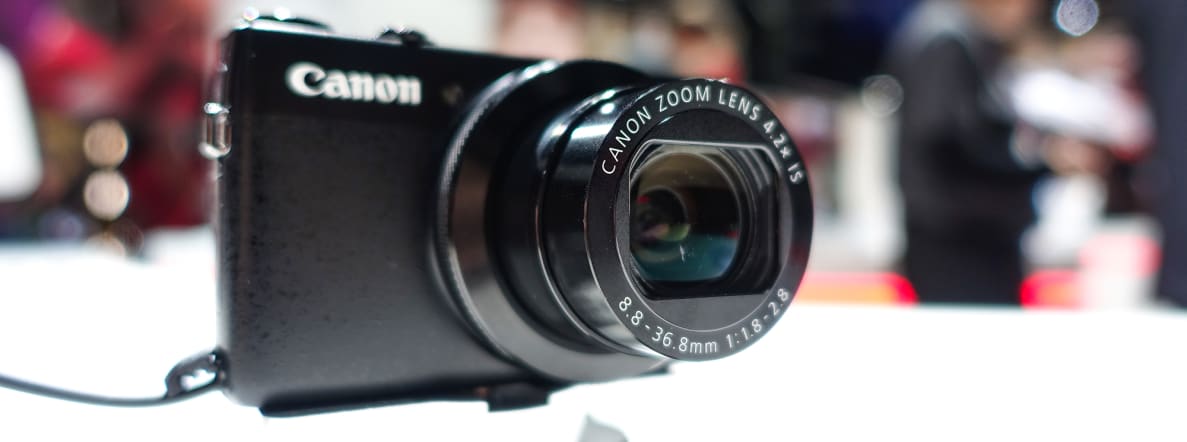But something was less than perfect with that last one. Was it too big, too expensive, or simply too much for the target market? Well, whatever the reason, Canon decided to go in a different direction, revealing the PowerShot G7 X (MSRP $699.99) at Photokina 2014.
The new model ditches the G1 X Mark II's 1.5-inch sensor for a smaller 1-inch unit in an attempt at true pocketability, cuts the price by $200, and retains much of the deep control and photographer-centric design that has distinguished the G-series from the start.
It's clear that Canon has been learning from watching Sony, and that's scary news for its rivals.
{{brightcove '3788062404001'}}
Design & Usability
Powerful, modern, derivative
The PowerShot G7 X is smaller and lighter than any other G-series camera in recent memory. At just 103mm x 60mm x 40mm, it's far smaller in every dimension than the PowerShot G16, despite the fact that its 1-inch sensor dwarf's the G16's 1/1.7-inch imager. In part, that's because it lacks the G16's optical viewfinder, ergonomic grip, and hot shoe, but really it's just a phenomenal job of packaging on the part of Canon's engineers.
Of course, it's also a feat Sony managed way back in 2012 with the original RX100. That camera—and both of its successors—are actually smaller than the G7 X.
The G7 X doesn't deliver a fantastic ergonomic experience—there's simply no grip around front, though there is a thumb rest on the back. Even so, the textured body material gives a little purchase, and the package is so small that you rarely feel like it'll slip out of your hand.
Build quality is superb without making the camera overbearingly heavy. All of the buttons provide satisfying clicks, there's no looseness or rattle in the joints, and no wobble in the lens barrel. In short, the G7 X feels every bit the high-end compact you'd expect at its $700 price point.
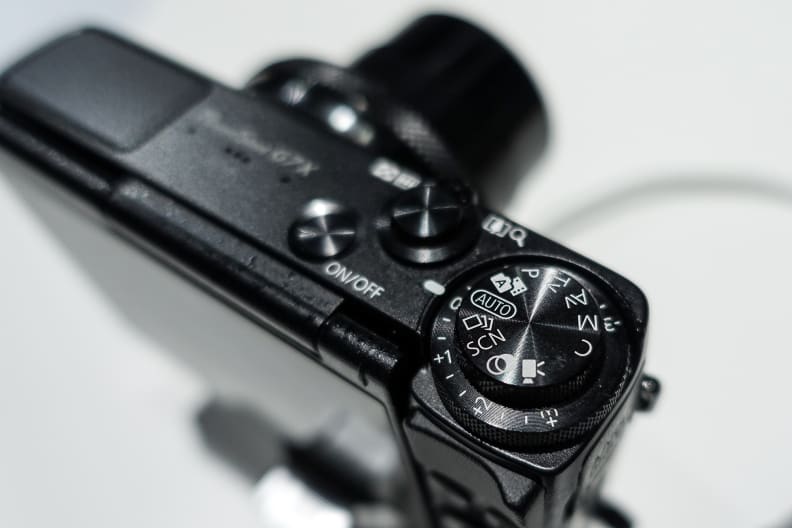
The mode dial is stacked atop the broader EV comp dial. A neat touch.
The knurled metal ring around the lens provides some extra grip, along with useful control customization. The tactile feedback from the ring is superb—far preferable in my mind to the Sony RX100 III's smooth rotation. Up top, the mode dial sits atop the exposure compensation dial (an arrangement more like what the Nikon Df offers than what we saw on the G16). Their motion is precise, and they're weighted heavily enough that it'll be hard to move either accidentally.
The 3-inch rear LCD is bright and clear, and mounted on a hinge that can swing up 180 degrees for the all-important selfie. The hinge is fixed, so you can't tilt the screen down or swing it out to the side, however. It's also a touchscreen—a notable advantage over the RX100 III. Like previous PowerShot touchscreens, it's a joy to use: responsive, intuitive, and legitimately useful.
{{ photo_gallery name="Design" }}
Features
Keeping up with the Joneses... more or less
The biggest story about the PowerShot G7 X is probably its 1-inch sensor. Specs-wise, it's very similar to Sony's own 1-incher, with an identical physical size, pixel count, and ISO range (125–12800). We'd stop short of speculating that proud Canon is stooping so low as to buy Sony silicon, but the similarities are striking.
The results are similar, too. Obviously, Canon and Sony use different JPEG processing tricks, so there will be small differences in the final output, but from what we saw on the show floor, it's going to be a tight race. Up through ISO 800, images looked very clean—even in the murky trade show lighting—and they seemed plenty usable even as high as ISO 3200. Of course, we'll have to wait for our full lab results to deliver a final verdict on image quality.
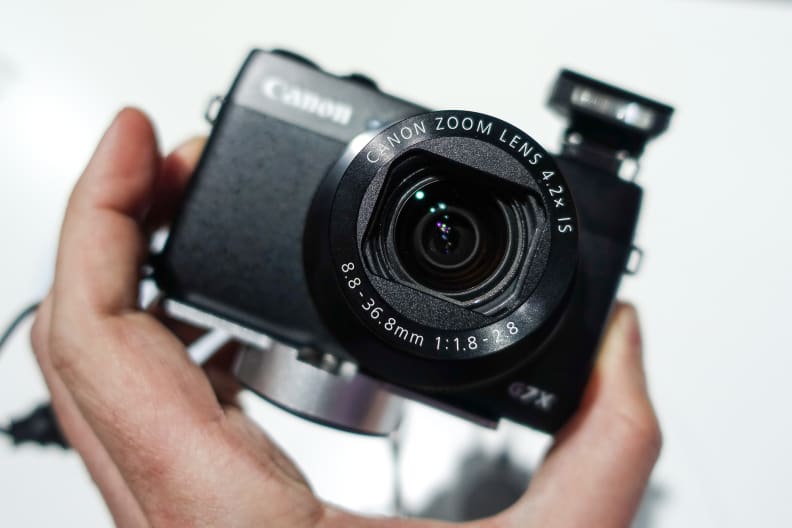
Spanning a focal range of 24-100mm, the G7 X handily outdoes the Sony RX100 III on optics.
One point where the G7 X conclusively outshines the RX100 III is in its lens. Though both cameras offer a bright f/1.8–2.8 aperture range, the G7 X's glass covers a 24-100mm (4.2x) equivalent range. The RX100 III can only manage 24-70mm equivalent (2.9x). It's not a huge difference, but for the right kind of shooter it could be a game-changer.
The 31-point autofocus system can focus down to 5cm (just under 2 inches), which is great for macro enthusiasts. In practice, Canon's AF is noticeably speedier than Sony's, though it's a game of inches rather than miles. The G7 X is quicker to lock on, and the ability to tap to focus gives it a real edge over the competition when quick work is required.
On the video front, the G7 X can shoot 1080/60p footage using h.264 compression. That's more or less par for the course, but Canon has a great track record with video quality, and we expect nothing less than greatness from this camera.
A prominent, bright-red record button sits at the bottom right-hand corner of the rear control cluster, making it easy to jump in and out of recording at a moment's notice. We accidentally triggered it a couple times while playing with the G7 X on the show floor, but we don't think it's a serious concern.
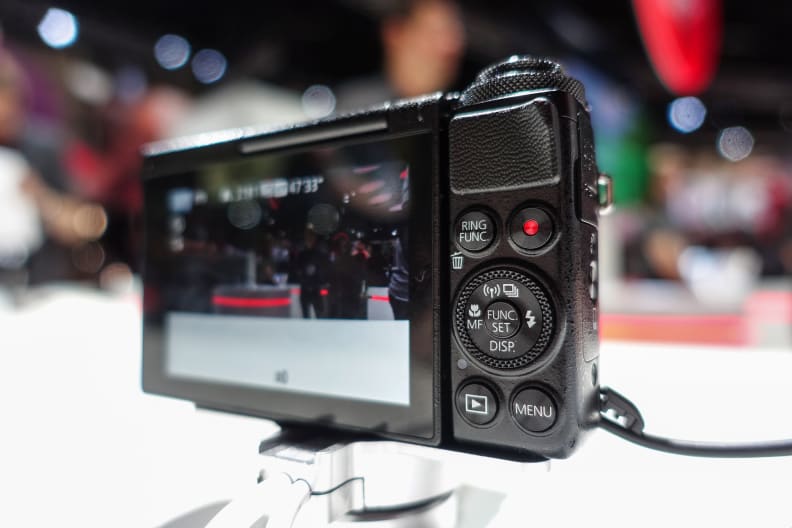
The rear control cluster will be familiar to anyone who's ever used a Canon G-series camera.
On the right side of the camera there's a Mobile Device Connect button that triggers the G7 X's WiFi/NFC radios and makes it easy to pair the camera with a smartphone or tablet. We didn't get to try it out at Canon's booth, but it should be quite similar to previous Canon WiFi implementations, which is to say... functional.
There's one last caveat: The G7 X's stated battery life is a scant 210 shots. In comparison (and with a very similarly specced battery) the RX100 III delivers 320 shots straight out of the box. Battery ratings are notoriously sketchy, but that's a big discrepancy.
Conclusion
A "me too" camera par excellence
Let's put this bluntly: Canon used to be the King of Compacts. It was an innovator, a leader in the market. But these days, it's very much a follower. Today's Canon prefers to sit back and see what the competition is up to, then pick and choose the trends it wants to follow.
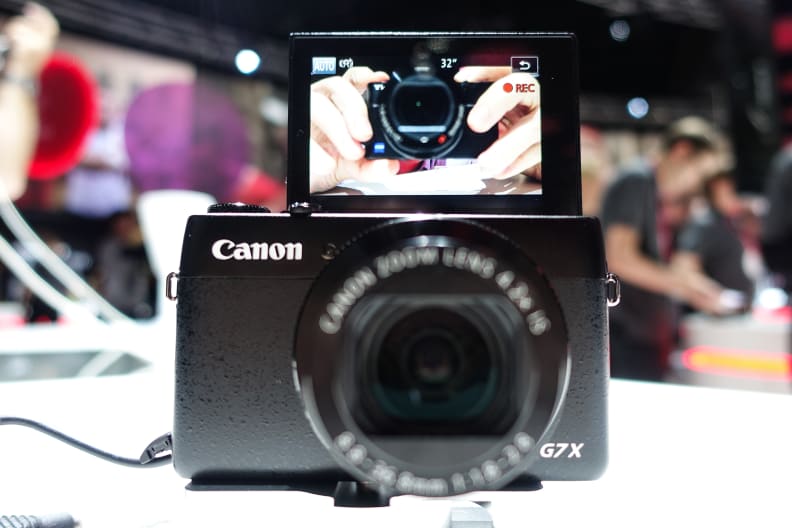
Like virtually every other small camera released this year, the G7 X has a selfie mode.
The G7 X is a perfect example. It's quite transparently Canon's attempt to emulate the success of Sony's RX100 family—the undisputed rulers of the advanced compact market for the last couple years.
But sometimes it pays to wait, and Canon has done a great job of aping its inspiration—even exceeding it in some key ways. Though we can't speak yet to its ultimate image quality, Canon's 24-100mm f/1.8–2.8 lens is an impressive achievement. The touchscreen interface and click-stop control dial are real operational improvements. And the $700 asking price—$100 less than the RX100 III—is going to win this camera plenty of fans.
But there are downsides, too. The G7 X lacks Sony's phenomenally clever pop-up electronic viewfinder, its tilt screen is more limited than the RX100 III's, and even with two years to try and beat Sony, it's still bigger and heavier, with worse battery life. (Granted, that last point is pending real world testing.)
All in all, the G7 X is very much a "me too" camera, but it could be a great one. More competition in this space can only be a good thing for consumers, especially if it drives prices down, so we're glad to see Canon learning from its rivals. We can't wait to get this little powerhouse into our labs and find out how it truly stacks up against a very stacked field.
Meet the tester
Ben is an experienced industry journalist who formerly served as Senior Editor of News and Features at Reviewed. He now contributes as a freelance writer and editor. Most recently hailing from the vast wilds of the American southwest, he is an avid photographer who is deeply disturbed by the lack of wide open landscapes in Boston.
Checking our work.
Our team is here for one purpose: to help you buy the best stuff and love what you own. Our writers, editors, and lab technicians obsess over the products we cover to make sure you're confident and satisfied. Have a different opinion about something we recommend? Email us and we'll compare notes.
Shoot us an email
